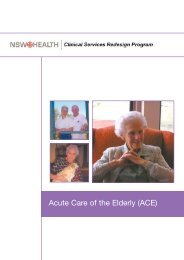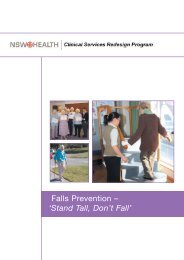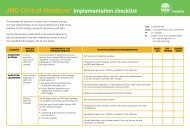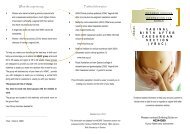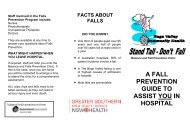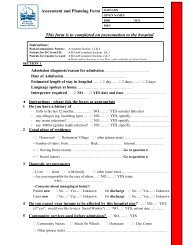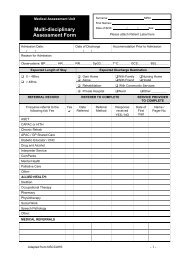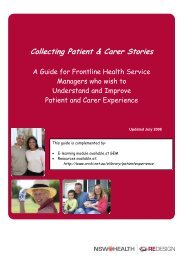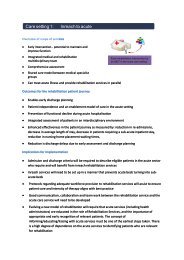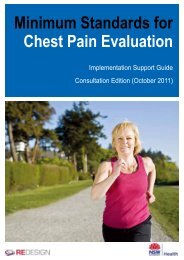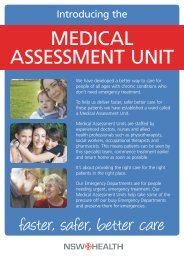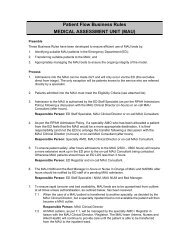A review of literature, 2006 ( pdf - 438 KB) - ARCHI
A review of literature, 2006 ( pdf - 438 KB) - ARCHI
A review of literature, 2006 ( pdf - 438 KB) - ARCHI
Create successful ePaper yourself
Turn your PDF publications into a flip-book with our unique Google optimized e-Paper software.
Macedonian Women’s Health Project<br />
Review <strong>of</strong> <strong>literature</strong><br />
___________________________________________________________________<br />
Behavioural influences<br />
Lifestyle factors such as nutrition, physical activity and use <strong>of</strong> alcohol and other drugs<br />
have a strong influence on the risk <strong>of</strong> disease, particularly cardiovascular disease<br />
and cancer. Some <strong>of</strong> these behaviours are also linked to social and economic factors<br />
discussed in the previous section.<br />
Nutrition<br />
A healthy diet is increasingly considered to make an important contribution to health<br />
and wellbeing. Over the last few decades, a growing body <strong>of</strong> evidence has linked<br />
food consumption patterns with the risk <strong>of</strong> a number <strong>of</strong> lifestyle diseases (Australian<br />
Institute <strong>of</strong> Health and Welfare 2004). Although no information was located on the<br />
nutritional status <strong>of</strong> Macedonian women in Australia, it could be expected that their<br />
diet would combine some elements <strong>of</strong> traditional Macedonian cuisine with<br />
contemporary Australian eating patterns.<br />
A report on the nutritional intakes in Macedonia over the last 30 years (World Health<br />
Organisation 2002) documented consumption <strong>of</strong> fruit, vegetables and dairy products<br />
below recommended levels. There were also some micronutrient deficiencies<br />
observed including anaemia and vitamin A and iodine deficiencies.<br />
Over the period monitored, rates <strong>of</strong> nutritionally related diseases in Macedonia such<br />
as cardiovascular disease, diabetes and some cancers have increased substantially<br />
– increasingly mirroring the morbidity and mortality patterns in other developed<br />
countries around the world.<br />
Physical activity<br />
Physical activity is an important factor in maintaining good health (Australian Institute<br />
<strong>of</strong> Health and Welfare 2004) and a particularly important aspect <strong>of</strong> cardiovascular<br />
disease prevention (Eyler et al 2003). Maintaining regular physical activity assists in<br />
improvement <strong>of</strong> cardiovascular risk factors such as high blood pressure, Type 2<br />
diabetes, being overweight, low levels <strong>of</strong> HDL (the ‘good’ cholesterol) and can help<br />
reduce the risk <strong>of</strong> some types <strong>of</strong> cancer. Other benefits are a reduction <strong>of</strong><br />
osteoporosis, reduction <strong>of</strong> stress, anxiety and depression (Australian Institute <strong>of</strong><br />
Health and Welfare 2004).<br />
One report examining the inequalities in risk factors and cardiovascular mortality<br />
among Australia’s immigrants found that women from southern European countries<br />
(ie the former Yugoslavia, Italy, Malta and Greece) had higher than average body<br />
mass index and extremely high levels <strong>of</strong> sedentariness (Bennett 1993).<br />
A study documenting levels <strong>of</strong> physical activity among Macedonian women in<br />
Newcastle in 1997 found their activity levels well below the national<br />
recommendations <strong>of</strong> thirty minutes a day <strong>of</strong> moderate level activity. Of the 33 women<br />
who volunteered to participate in a heart health program, 76 percent reported having<br />
done no vigorous exercise and 40 per cent reported that they had not exercised at all<br />
during the previous six months (Brown et al 1997). In comparison, in the National<br />
Physical Activity Survey in 2000, 13 percent <strong>of</strong> Australian women reported doing no<br />
physical activity during the previous week (Australian Institute <strong>of</strong> Health and Welfare<br />
- 22 -



